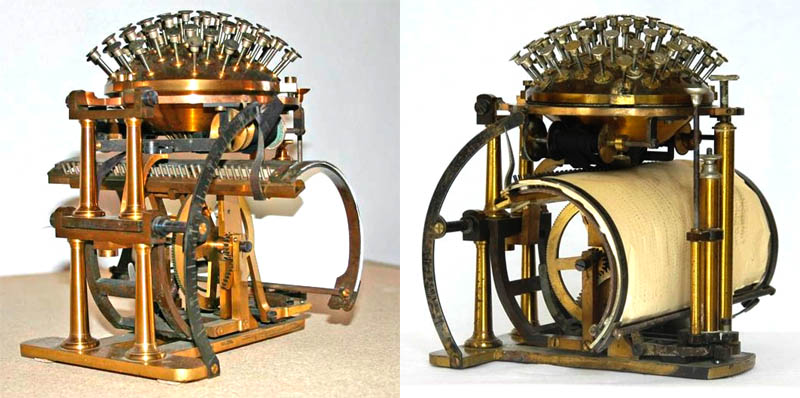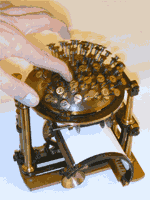 "QUANTUM SHOT" #656 "QUANTUM SHOT" #656Link - article by M. Christian and A. Abrams Beautiful Typewriters From 'The Good Old Days' Horse and buggies, hoop skirts, steam engines, bustles ... oh, yes, life around the turn of the previous century was a delight of simplicity and workmanship. But that doesn't mean that the artisans and engineers of way-back-when didn’t at least have their hearts and minds in the right place.  (images via The Typewriter Museum) Take, for example, what writing used to be like before a few very bright bulbs thought to create machines to make it easier: pens that constantly ran dry, ink that spilled or smeared, illegible handwriting ... getting the message across -- any message across -- by hand was problematic at best, totally confusing at worst. Linear Index Typewriters and "Typewritors" One of the earliest of those bright bulbs was William Austin Burt who, in 1829, created what he called a 'typewritor.' If Burt's machine was, in fact, the first is a matter of much debate - as another, similar, machine had also been built by Pellegrino Turri around the same time. Some even say the crown of 'first' should go to Henry Mill, who created a writing machine way back in 1714. All of these devices represented just baby steps: more potential than actual ability to help with clear, concise and fast writing. There were a lot of others after these early pioneers, but none of them were ever a real commercial success. Looking at them you can see why: in many of these very early models – called 'index typewriters,' by the way – the typing was done by selecting the letter to be used on a slider and then pressing it against the paper. To call these early monsters 'slow' is being kind. Changing the alphabetical slider to a disc version helped a bit but not enough to make any of these machines easy or popular. Here is a "Linear Typewriter": one look at this machine and you can see why it was never a big hit. Just think about transcribing anything on this beast:  (images via Office Museum) The 1890 Victor: "Take a letter, Miss Jones."  (images via Office Museum) The Writing Ball That Will Warp and Enchant Your Mind In 1865 what many consider to be the true ancestor to true, efficient, and financially successful typewriter was developed by Rasmus Malling-Hansen: The Writing Ball. Not only was it efficient, but also strangely elegant, even beautiful: just look at it - a brass half-sphere covered with keys above a cylinder that held the paper. It was finely made, unlike some of the unsuccessful machines before, looking more like a gentleman's watch than a piece of office equipment:  (image credit: Auction Team Koln, via) The Malling-Hansen Writing Ball: not only one of the first commercial typewriters but also one of the most elegant (more pics and auction price info):  (images credit: Auction Team Koln, via The Malling-Hansen Society) The Beauty of the Ball - It may have been difficult to use but it sure looked good on your desk:  (image credit: Auction Team Koln, via) An Illustration of the Malling-Hansen Writing Ball: a lovely etching of the typewriter ball by Hans Gerhard Blodorn - buy a copy here  (image credit: Hans Gerhard Blodorn) More pretty pictures of Hansen's lovely creation at The Typewriter Museum:  (images credit: The Typewriter Museum) Sure, Hansen's Ball had some rather serious flaws – like the fact that it was hardly cheap and, because of the position of the ball and the paper under it, the typist really couldn't see what they were typing until they were done and the paper was removed from the machine -- but that didn't stop it from selling better than many other previous models. One quirk of the ball was that, unlike the QWERTY keyboard that pretty much every typewriter after it had and every computer now has, the ball's keys had been positioned to make typing easier for the typist and not the typewriter. The Sad, Strange Story of QWERTY By the way, in case you don't know the sad, strange story of QWERTY – which haunts us to this day -- the alphabet were originally put in that order because otherwise users would type faster than the machine could handle, thus jamming the keys. So QWERTY was created to keep that from happening: to keep the machine happy at the cost of typist efficiency. Here's a fun bit of trivia for you folks now interested in Malling-Hansen's elegant writing ball: one particular person was interested in this new, wondrous invention – a celebrated writer who was having a hard time with his diminishing eyesight. While Nietzsche did get and use his writing ball he sadly didn't love it – though it is fascinating to visualize the author of Thus Spoke Zarathustra clicking and clacking on the mechanical beauty of one of Hansen's creations.  Balls Of Every Shape And Size Hansen didn't stop with his first creation. Over the years after the release of his first ball he created a whole range of machines with all kinds of variations: A handsome selection of Malling-Hansen Writing Balls, including a lovely one in a wooden case can be found at The Malling-Hansen Society -  The Miniature Writing Ball (more info and pictures here):  (images via) The cryptographic writing ball by Alexis Kohls, circa 1883 -  Another fascinating keyboard variation: The Piano-style Keyboard - American-made Hammond from 1880:  (image via) Eventually, though, other – and cheaper – machines were developed, saving generations of writers, secretaries, business people, and anyone else who used to have to put pen to paper, from cramp and bad handwriting. Though Hansen and his elegant ball have been almost lost to time it's nice to be able to show a new, QWERTY-slaved generation, the beauty of his creation. CONTINUE TO "CURTA MECHANICAL CALCULATORS"! ->
|
Hansen's Writing Ball & Other Unusual Typewriters
Subscribe to:
Post Comments (Atom)
Check out this stream
Blog Archive
-
▼
2010
(569)
-
▼
October
(88)
- Tutorial - How to Make a Handbag
- Tutorial - How to Make a Stenciled Tray Mat
- Tutorial - How to Make a Large Purse with Pockets
- Siberian "Ghost" Cities Scare
- Tutorial - How to Cook Ground Beef Perfectly and a...
- Tutorial - How to Take in a Too Big T-Shirt
- Tutorial - How to Make an Easy Fabric Flower Pin
- Link Latte 144
- Tutorial - How to Make Four Petal Beaded Flower Ch...
- Tutorial - How to Make a Basket Wire Bird
- Tutorial - How to Make a Fleece Toddler Jacket
- Tutorial - How to Make Easy Scrunchies
- Tutorial - How to Create an Embossed Watermark in ...
- Tutorial - How to Make a Winsome Windows Fabric Mo...
- Tutorial - How to Make Ribbon Hair Bows
- Tutorial - How to Make a Vintage Barbie Doll Dress
- Tutorial - How to Make Framed Wall Art
- Tutorial - How to Make Googly Eyed Pumpkin Cookies
- Tutorial - How to Make Recycled Halloween Bunting
- Tutorial - How to Paint a Snowman
- The Ultimate Moving: Troll-A Gas Platform
- Tutorial - How to Make a Jack-O-Lantern Shirt
- Tutorial - How to Make a Pumpkin Beanie
- Pumpkin Coloring Pages Collection 2010
- Tutorial - How to Make a Braided Headband from Rec...
- Tutorial - How to Take in a Sweater
- Recipe - How to Make Chewy Granola Bar
- Tutorial - How to Make a Fabric Kindle Cover
- Paper Parkour
- Tutorial - How to Make Scannography Art
- Tutorial - How to Make a Schoolwork Organization Box
- Tutorial - How to Make a Candle Holder
- Tutorial - How to Make a Tea Card
- Tutorial - How to Make Wooden Halloween Blocks
- Tutorial - How to Make Halloween Tulle Ghosts
- Tutorial - How to Make Glow-in-the-Dark Hand Shape...
- Tutorial - How to Make a Travel Map Corkboard
- Extreme Parenting & Wild, Wild Kids!
- Tutorial - How to Make a Children's Activity Bag
- Tutorial - How to Make a Burlap Ruffle Frame
- Tutorial - How to Make Pumpkin Halloween Outfits
- Tutorial - How to Make Witch Legs
- Tutorial - How to Create Collage Backgrounds
- Tutorial - How to Make a Sleepy Owl Hat
- Tutorial - How to Outline an Entire Novel in Less ...
- Tutorial - How to Make Fall Napkin Rings
- Tutorial - How to Keep Blog Roll Updates on a Priv...
- Tutorial - How to Make a Primitive Fall Twig Wreath
- Hansen's Writing Ball & Other Unusual Typewriters
- Tutorial - How to Make a No Sew Dog Shirt
- Tutorial - How to Make a Say Boo! Wall Hanging
- Recipe- How to Make Caramel Apple Cookies
- Tutorial - How to Make a Fabric Chili Pepper Garland
- Tutorial - How to Get Started with Digital Scrapbo...
- Tutorial - How to Make an Ethnic/Bohemian Headband
- Tutorial - How to Make a Sleeved Toddler Bib from ...
- Tutorial - How to Make a Rag Rug
- Tutorial - How to Make a Bow Clipboard
- Link Latte 143
- Tutorial - How to Find and Install Cute Fonts
- Tutorial - How to Make a Headband from Dress Smock...
- Tutorial - How to Make an External Hard Disk Cover
- Tutorial - How to Tea Dye
- Tutorial - How to Make a Computer Keyboard Wrist Rest
- Tutorial - How to Make a Portable Ironing Board an...
- Tutorial - How to Make Spider Barrettes
- Tutorial - How to Make a Simple Book Bag
- Crochet Pattern - How to Make a Baby Girl Panda Am...
- The Rubik's Fix - Cubes, Spheres & More
- Tutorial - How to Make a Leather Insert Jeans and ...
- Tutorial - How to Make a Zippered Pencil Case
- Tutorial - How to Make a Tunic Blouse from Fringed...
- Tutorial - How to Make Lava Lamp Lip Gloss
- Tutorial - How to Make a CD Case Calendar
- Tutorial - How to Make a Juice Container Fabric Pu...
- Tutorial - How to Make Fabric Flowers
- Free Pattern - How to Make a Halloween Pin
- Tutorial - How to Make a Baby Kimono Top
- Our Little Robot Buddies
- Tutorial - How to MakeTube Pumpkins
- Most Sensuous Car Shapes Ever Designed
- The Most Shapely Car Ever Built?
- Tutorial - How to Make an End of Bed Bag
- Tutorial - How to Make No Sew Sweater Sleeve Pumpkins
- Exchange Program - How to Make a Blood Tank-Top
- Tutorial - How to Make an Accessories Hanger
- Jaw-Dropping Concepts from Alfa-Romeo, 1953-1955
- Archive: September 2010
-
▼
October
(88)








0 comments:
Post a Comment